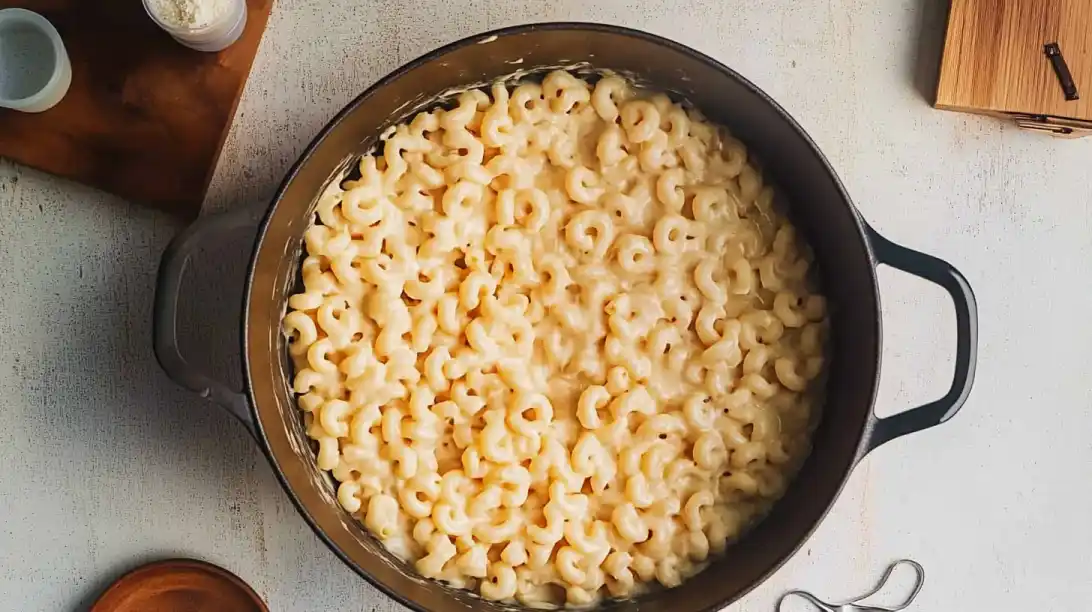The Best Fluffy Pancakes recipe you will fall in love with. Full of tips and tricks to help you make the best pancakes.

In this article, we’ll show you how to make a completely unique version of cottage cheese mac and cheese while keeping it rich, velvety, and absolutely mouthwatering. Plus, we’ll add some secret flavor boosters and customizable variations to make it your own.
Table of Contents
Let’s get cooking! 🔥
📌 Why Use Cottage Cheese in Mac and Cheese?
The Benefits of Cottage Cheese
Cottage cheese might not be the first thing you think of when making mac and cheese, but trust us, it’s a game-changer! Here’s why:
- High in Protein: Cottage cheese packs a protein punch, making your mac and cheese more satisfying.
- Lower in Fat: Compared to heavy cream or full-fat cheese, cottage cheese gives a creamy texture with fewer calories.
- Creamy & Velvety Texture: Blending cottage cheese creates a smooth, dreamy sauce without the need for butter or heavy cream.
- Mild, Adaptable Flavor: It absorbs spices and seasonings, so you can customize it to your liking!
🛒 Ingredients You’ll Need
To keep things simple, here’s a basic but delicious version of Cottage Cheese Mac and Cheese:
Main Ingredients
✔️ 8 oz elbow macaroni (or any pasta of choice)
✔️ 1 cup cottage cheese (full-fat for best results)
✔️ 1 cup milk (2% or whole milk recommended)
✔️ 1 tablespoon cornstarch (for thickening)
✔️ 4 oz shredded sharp cheddar cheese (about 1 cup)
✔️ ½ teaspoon garlic powder
✔️ ¼ teaspoon smoked paprika
✔️ Salt & black pepper to taste
Optional Add-Ins for Extra Flavor
✨ Parmesan Cheese – for a nutty, umami kick
✨ Dijon Mustard – enhances the cheesiness
✨ A Dash of Hot Sauce – for a subtle heat boost
✨ Steamed Broccoli or Spinach – for added greens
✨ Crispy Bacon Bits – for a smoky, savory crunch
👨🍳 Step-by-Step Recipe for the Creamiest Cottage Cheese Mac and Cheese
Step 1: Cook Your Pasta
- Bring a large pot of salted water to a boil.
- Cook your pasta al dente (firm but tender), following the package instructions.
- Drain and set aside.
Step 2: Blend the Cottage Cheese Sauce
- In a blender, add:
✔️ Cottage cheese
✔️ Milk
✔️ Cornstarch
✔️ Garlic powder & paprika
✔️ Half of the shredded cheddar cheese - Blend until completely smooth and creamy.


Step 3: Heat the Sauce
- Pour the blended sauce into a large pan over medium-low heat.
- Stir constantly for 4-5 minutes until the sauce thickens.
- Add the remaining cheddar cheese and stir until fully melted.

Step 4: Combine & Serve!
- Add your cooked pasta to the pan.
- Stir well, coating every piece of pasta with that creamy, dreamy sauce.
- Taste and adjust seasoning as needed.
- Serve hot and enjoy!

🔀 Variations & Customizations
Want to get creative? Here are some delicious twists on this cottage cheese mac and cheese recipe:
🔥 Baked Cottage Cheese Mac and Cheese
- Transfer the cooked mac and cheese to a greased baking dish.
- Sprinkle panko breadcrumbs and extra cheese on top.
- Bake at 375°F (190°C) for 10-12 minutes until golden brown and crispy.
🥦 Veggie-Packed Version
- Add roasted broccoli, spinach, or peas for a healthy, colorful twist.
🌶 Spicy Kick
- Stir in chopped jalapeños or a few dashes of sriracha for heat lovers.
🧄 Garlic Butter Infusion
- Sauté minced garlic in butter before adding the sauce to amp up the flavor.
🍽 What to Serve with Cottage Cheese Mac and Cheese
Pair your mac and cheese with these amazing sides:
✅ Cottage Cheese Chips – A crispy, protein-packed snack.
✅ Garlic Parmesan Sauce – Drizzle over for extra richness.
✅ Vegan Chopped Salad – A fresh, crunchy side to balance the richness.
✅ Air-Fried Chicken Tenders – For an indulgent, protein-filled meal.

💡 Pro Tips for the Best Cottage Cheese Mac and Cheese
✅ Use Full-Fat Cottage Cheese – It creates a silkier sauce.
✅ Blend Until Completely Smooth – No one wants lumps in their mac and cheese!
✅ Don’t Overheat the Sauce – Too much heat can cause it to separate.
✅ Grate Your Own Cheese – Pre-shredded cheese has anti-caking agents that affect texture.
✅ Customize the Spices – Try nutmeg, cayenne pepper, or even a pinch of cumin for unique flavors.
The Science Behind Cottage Cheese in Mac and Cheese
Most people are surprised when they hear about cottage cheese in mac and cheese. Why? Because cottage cheese has a unique texture, unlike traditional creamy cheeses like cheddar or gouda.
But here’s the secret: When blended, cottage cheese becomes silky smooth, acting as a natural thickener without needing butter or heavy cream. The high protein and casein content create a structure that makes the sauce stick to the pasta better than traditional mac and cheese recipes.
Link to Best Melting Cheese for Quesadillas to explore the melting properties of different cheeses.
Nutritional Benefits of Cottage Cheese Mac and Cheese
If you’re looking for a high-protein, lower-fat alternative to classic mac and cheese, cottage cheese is a fantastic option.
| Nutrient | Cottage Cheese (1 cup) | Cheddar Cheese (1 cup) |
|---|---|---|
| Calories | 206 | 402 |
| Protein | 28g | 24g |
| Fat | 9g | 33g |
| Calcium | 14% DV | 72% DV |
Key Benefits of Cottage Cheese Mac and Cheese:
- High in Protein: Great for muscle recovery and keeping you full longer.
- Lower in Fat: Less saturated fat compared to heavy cream-based mac and cheese.
- Rich in Calcium & Vitamin B12: Essential for bone health and energy levels.

Link to Quick Healthy Meals for Busy Lifestyles to promote other nutritious recipe ideas.
How to Choose the Best Cottage Cheese for Mac and Cheese
Not all cottage cheese brands taste the same. Some are grainy, while others are smooth and creamy. To get the best mac and cheese texture, follow these tips:
✔ Best Cottage Cheese for Cooking:
- Full-fat cottage cheese (4%) – Creamier and blends better.
- Small curd vs. large curd – Small curds blend more smoothly.
- Organic brands – Tend to have a cleaner taste with fewer additives.
- No added thickeners – Avoid brands with stabilizers like guar gum.
Link to Cottage Cheese Flatbread for more ways to use cottage cheese in recipes.
Can You Make Cottage Cheese Mac and Cheese Without a Blender?
Absolutely! If you don’t have a blender, here’s how to get a smooth, creamy sauce:
✔ Whisk Method: Mash the cottage cheese with a fork and whisk it with milk until smooth.
✔ Food Processor: If you don’t have a blender, a food processor will work.
✔ Straining Method: Push the cottage cheese through a fine mesh sieve to remove curds.
✔ Melting Method: Heat cottage cheese with milk over low heat, stirring constantly.
Link to Mastering Easy Dinner Recipes for other quick dinner solutions.
Dairy-Free and Vegan Alternatives for Cottage Cheese Mac and Cheese
If you love the concept of creamy mac and cheese but need a dairy-free version, here’s how to do it:
✔ Vegan Cottage Cheese Substitute: Use blended silken tofu or cashew cream.
✔ Dairy-Free Cheese Alternatives: Use nutritional yeast or vegan shredded cheese.
✔ Milk Substitutes: Almond, oat, or soy milk work best.
✔ Thickening Agents: Use tapioca starch or arrowroot flour instead of cornstarch.
Link to Cottage Cheese Chips for another plant-based snack alternative.
How to Store and Reheat Cottage Cheese Mac and Cheese
Want to meal prep or save leftovers? Here’s how:
✔ Refrigeration: Store in an airtight container for up to 3 days.
✔ Reheating on Stovetop: Add a splash of milk and heat on low, stirring frequently.
✔ Microwave Method: Heat in 30-second intervals, stirring in between.
✔ Freezing: Not recommended, as the texture can become grainy.
Link to Quick Healthy Meals for Busy Lifestyles for other meal prep-friendly recipes.
Common Mistakes to Avoid When Making Cottage Cheese Mac and Cheese
- Overheating the Sauce – Heat low and slow to prevent curdling.
- Using Pre-Shredded Cheese – It contains anti-caking agents that affect melting.
- Skipping the Blending Step – This ensures a silky, lump-free sauce.
- Using Skim Cottage Cheese – Results in a thinner, less creamy texture.
Link to Garlic Parmesan Sauce to help fix a bland sauce.
Fun Ways to Serve Cottage Cheese Mac and Cheese
✔ Mac and Cheese Bar – Set up bowls of toppings like bacon, jalapeños, and crispy onions.
✔ Stuffed Peppers – Bake inside bell peppers for a unique twist.
✔ Mac and Cheese Bites – Scoop into muffin tins and bake until golden.
Link to Birthday Party Food Ideas for fun meal planning inspiration.
❓ FAQs About Cottage Cheese Mac and Cheese
Can I use low-fat cottage cheese?
Yes! But full-fat cottage cheese will give a richer, creamier result.
Can I make this gluten-free?
Absolutely! Use gluten-free pasta and make sure your cornstarch is gluten-free.
How do I store leftovers?
Store in an airtight container in the refrigerator for up to 3 days. Reheat with a splash of milk to maintain creaminess.
Can I freeze this mac and cheese?
Yes, but the texture may change slightly. Freeze in an airtight container for up to 1 month.
What other cheeses work well with this recipe?
Try a mix of Gouda, Monterey Jack, or Fontina for a different flavor profile.
🔥 Final Thoughts
Cottage Cheese Mac and Cheese is the perfect balance of creamy, cheesy, and nutritious. Whether you’re looking for a high-protein comfort food or a healthier mac and cheese alternative, this recipe delivers BIG on flavor without sacrificing indulgence.
Give this recipe a try and let us know how you customized it!
Enjoy your creamy, dreamy mac and cheese! 🍽️🧀









[…] those who enjoy creamy dishes, using a flavorful liquid base similar to what’s used in this cottage cheese mac and cheese can provide depth to your […]